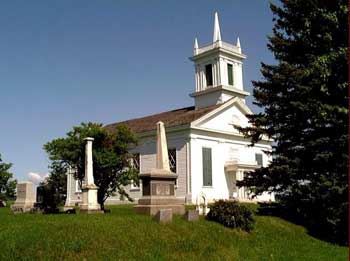
St Paul’s Dutch Reformed Church or Manheim Reformed Church or Snells Bush Church, Manheim, New York
Manheim is very nearly the central point of New York state and is five miles east of Little Falls. It has been an immemorial tradition in the community that the town was called by Dr. Wm. Petry out of his personal associations in a town of the same name in Baden, Germany. Manheim was set off as a town from Palatine on March 3, 1797, and on April 7, 1817, it was annexed to Herkimer county. Originally Sir Wm. Johnson owned all the land hereabout, the same having been granted to him a few years before his death by King George, some forty thousand acres in all, called the Royal Grant. The oldest patent of land in the town was given to Rev. Petrus Van Driesen who for a quarter century was in the old First Dutch church of Albany. This grant was made in 1737 and contained twenty-five hundred acres. With him was joined Rev. John Jacob Ehle, and both of these men conducted a mission among the Indians, Ehle keeping at the work at what is now called Fort Ehle (still standing), for upwards of half a century, or until his death, about 1780.
Originally the town of Manheim was in what was known as the Stone Arabia district, created in 1772, but in the following year the same was changed to Palatine district.
In March, 1778, the Indians and Tories invaded the settlement and caused general devastation, some scalps were taken besides quite a number of prisoners. Among the families who suffered were those of Cobus Mabee, Conrad, Joseph, Abram and Jacob Klock, Mabus Forbush, Robhold Ough, Adam and Rudolph Furrie, Henry Shafer, John and Michael Keyser, Calvin Barnes.
Between 1786 and 1796 the supervisors of the town were: John Frey, Christian Nellis, Jacob Eaker, Frederick Getman, Samuel Gray, and Jacob Snell. Judging from the votes cast for Governor, in 1786 tbere were a thousand population in the town then, while in 1796 there were over six hundred electors, indicating a population of thirty-five hundred.
With the settlement of the town of Mannheim in 1770 the people who were mostly German, soon formed the first church organization, and as they had to depend on the Stone Arabia Dutch Reformed church for preaching, naturally the organization followed that denomination.
Most of the inhabitants were conservative and uneducated. They did not keep up either their German language or adopt the English, but used what was called a Mohawk Dutch. But with the coming of the New England settlers, who were better educated and more enterprising, and with the English preaching and English teaching in the schools, the community assumed a higher condition in morals and education.
Sometime before the Revolution there were four of the Snell brothers, Jacob, Joseph, Peter,and Suffrenus, who gave seven acres of land for the church and twelve acres for the school. So many Snells lived in the vicinity that the place was popularly known, and is in a measure to this day, as “Snell’s Bush.” The first church built was burned sometime during the Revolution.
The second church, probably erected soon after the war, served the congregation until 1850, when it was taken down, part of its timber used in the construction of the new edifice. On January 8, 1850, at a meeting of the congregation it was voted to build a new “St. Paul’s Reformed Protestant Dutch church” to be sixty by forty feet, and the following committee was appointed to build it: John Markel, Peter P. Snell, and Jacob Yoran. The consistory at this time consisted of elders, Peter A. Timmerman and Jacob Yoran; deacons, John Garlock and Levi Timerman. The “slips” (pews) were sold on February 3, 1851, for $4,464, and among the purchasers were eighteen Snells and ten Timermans. Peter P. Snell’s family was so large that he bought two pews for $221, while Adam A. Feeter paid $141 for a single pew, and Jehoram Snell $136 for a pew.
All but half an acre of the nineteen acres given by the Snells was finally deeded to the church, an act of the legislature being necessary to consummate the deal and establish the title.
In 1801 the Rev. Caleb Alexander who was travelling through the country wrote, “between Fairfield and Little Falls is a Dutch settlement called Manheim-rich farms, a meeting house and a minister. The church was at first called the Reformed Calvanist church, and was incorporated in 1792. Originally it was a German Reforrmed church, and is called “St. Paul’s” in the incorporation article. It united with the Montgomery Classis September 27, 1822.
The church cemetery has recently been cleared and beautified and may be seen for many miles, on the high land surrounding the church. The principal burials are the Snells, Timmermans, Yourans, Feeters, Garlocks and Markells. The oldest stone in the yard marks the burial spot of Peter Snell who was born in 1731 and died in 1804. Other burial spots not far distant, as the one on the Beardsley farm where many of the Kilts family are interred, and another surrounding the Lutheran (“Yellow”) church, where many of the original settlers were buried, as the Keysers, Windeckers, Bellingers, Petries et al. were laid to rest, are interesting spots for the student of the early history of the town of Manheim and the valley of the Mohawk.
(Note: The church has been closed for some time. It is owned by the Snell/Zimmerman/Timmerman families and maintained by them.)
Excerpts from “The History of Montgomery Classis, R. C. A., 1916”, by W. N. P. Dailey